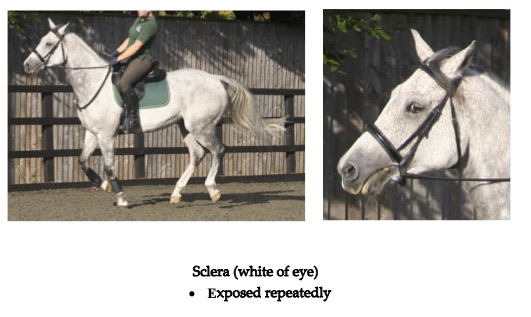Undiagnosed Pain in Horses
By Lisa Turcotte CEMT
Recently I had the opportunity to watch a lecture given by Dr. Sue Dyson MA Vet MB PhD DEO DipECVSMR FRCVS who is a world-renowned expert in equine orthopedics, with a particular interest in lameness and poor performance in sports horses.
The topic of the lecture was Application of the Ridden Horse Pain Ethogram.

Dr. Dyson developed the Ridden Horse Pain Ethogram (RHpE) which comprises 24 behaviors, the majority of which are at least 10 times more likely to be seen in lame horses compared with non-lame horses. The observation of ≥8/24 behaviors is likely to reflect the presence of musculoskeletal pain, although some lame horses score <8/24 behaviors. (1)
As a professional equine massage practitioner, I am constantly looking to improve my understanding of pain in horses and to improve my ability to see it. Horses have a great ability to mask their pain. It is in their nature as a prey animal to do this. For them it is a matter of survival. Showing any weakness is an almost sure indicator of their death due to a predator. Domesticated horses no longer need to worry about the saber-toothed tiger or pack of wolves attacking them. Yet despite their relative safety they still have the innate drive to hide their pain.
As individuals gifted with their presence and given the responsibility of their care, it is important that we recognize times when pain happens in our horses. Horses are very subtle in their interactions within the herd and humans; thus, it makes it very difficult to recognize signs of pain. Luckily all of Dr. Dysons research makes it easier for us to determine the severity of pain horses feel.
In one study done by Dr. Dyson, a test pool of 148 amateur and professionally owned horses showed that 28.4% were lame in hand while 62.2% were lame when ridden. Furthermore 13 of the lame in hand horses were not lame when ridden and 63 horses were lame when ridden but not in hand. Also 60% of the test horses were lame at the canter. (2)

The implications of this and other studies done by Dr. Dyson show that a
- A disturbingly high proportion of horses were lame when ridden (62%).
- Ridden performance problems must be assessed during riding as many horses will not look lame in hand.
- There is a strong association between lameness and the RHpE score.
- Saddle fit for both the horse and rider is extremely important
So, what is the number of behaviors that tells us our horses are in pain. In the studies non-lame horses had a maximum of occurrences of 6/24 with the common score was 2 out of 24. The lame group of horses had a maximum of occurrences of 14 with 9 being the most frequent. The threshold of 8 of the behaviors was determined to be a significant indicator of Musculo-skeletal pain.

A partial list of behaviors include (3):
- Repeated change of position of the head, not in rhythm with the trot
- Head tilted or repeated tilt
- Head in front of the vertical >30 degrees for 10 seconds or longer or behind the vertical < 10 degrees for 10 seconds or longer
- Eye lids closed or half closed for 2-5 seconds and/or frequent blinking
- Sclera (white of eye) exposed repeatedly
- Rushed gait- more than 40 trot steps in 15 seconds
- Slow gait – less 35 trot steps in 15 seconds
What does this mean to us as owners and riders? We can educate ourselves on the 24 behaviors of the RHpE. Only by recognizing the subtle signals our horses give us can we ensure they perform at their best. The first place to start helping is to contact your veterinarian and when a diagnosis becomes available, seek help from individuals that are either certified or licensed to work on your horse such as Massage Practitioners, Chiropractors, Acupuncturists and qualified saddle fitters .
For a complete list of the 24 behaviors please visit my website to download the study results. Additionally, I am happy to review videos to give you my opinion of the scores and discuss whether massage is an appropriate step to take to help ease muscle soreness or tightness.
Sources
1. S. Dyson The Ridden Horse Pain Ethogram 2021
2. Dyson, S. et al. Gait abnormalities and ridden horse behaviour in a convenience sample to the United Kingdom ridden sports horse and leisure horse population Equine Vet. Educ 2020
3. DYSON, S., BERGER, J., ELLIS, A. D. & MULLARD, J. 2018.Development of an ethogram for a pain scoring system in ridden horses and its application to determine the presence of musculoskeletal pain. Journal of Veterinary Behavior, 23, 47-57.
